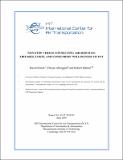| dc.description.abstract | Airlines provide both non-stop and connecting services. The airfare for each
service type is determined largely by the willingness to pay (WTP) of passengers
and the costs for airlines. This paper estimates the impact of itinerary
characteristics such as number of stopovers, detour, layover time, and aircraft size
on airfares using a novel demand and supply model. This model allows us to
calculate both costs and markups for non-stop and connecting itineraries in U.S.
domestic markets. We find that, on average, passengers have a higher WTP for
nonstop flights and the WTP for connecting flights is driven particularly by the
number of stopovers, in-flight time, and transfer time. As a result, we identify
significant heterogeneity with regard to costs and mark-ups between markets.
While in most U.S. domestic markets airlines incur higher costs for operating
connecting routings, the indirect routing via a hub achieves lower costs in some
markets, as the economies associated with the use of larger aircraft offset the costs
of the stopover. Finally, we show that the presence of connecting services reduces
fares for nonstop flights, in particular for itineraries with a longer market distance
as detours and the significance of fixed costs associated with a stopover decrease. | en_US |
